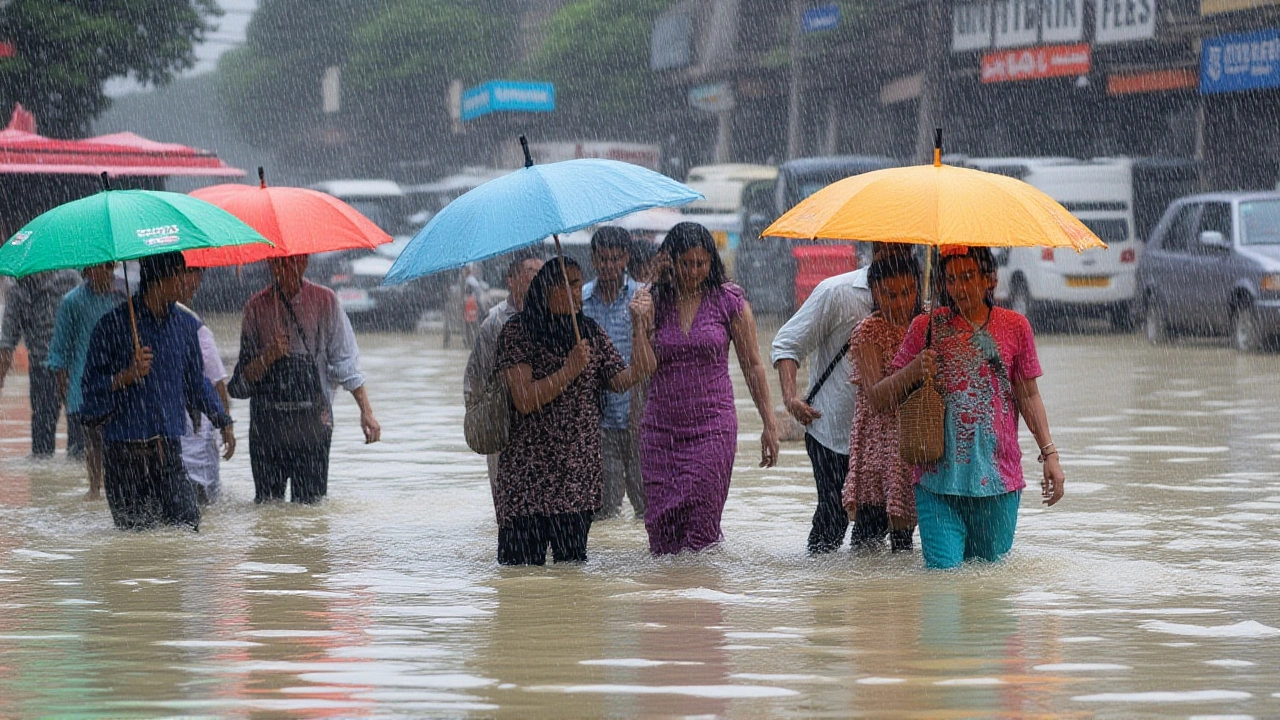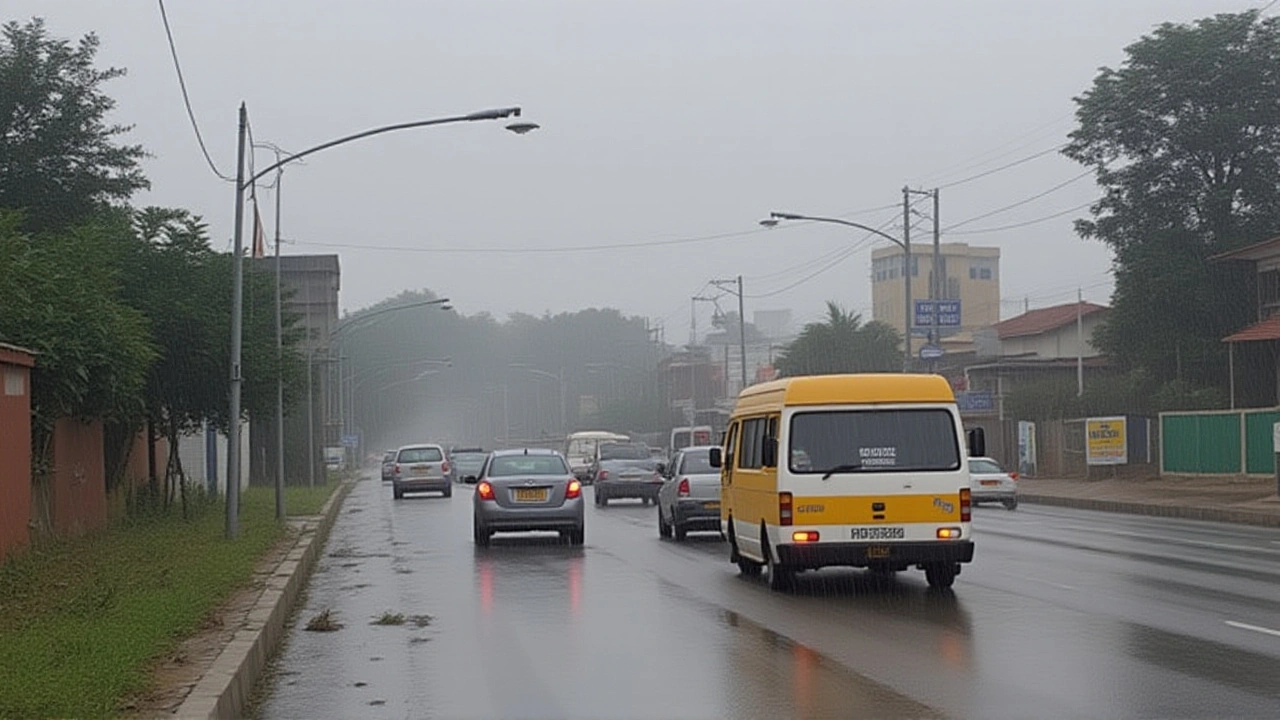When Kenya Meteorological Department released its seven‑day outlook on Tuesday, July 22 2025, it warned that rain, cold and cloudy skies will linger across the highlands and Rift Valley. The forecast, detailed by journalist Janeffer Katila, covers Tuesday, July 22 through Tuesday, July 28 and targets twenty‑one counties from Kakamega to Narok. Farmers, disaster responders and commuters are urged to brace for morning sunshine that can turn into afternoon thunderstorms, according to the department’s analysis.
Forecast Overview: What to Expect
The KMD’s outlook breaks the week into three daily windows. Mornings will start with intermittent sunshine, especially over the Lake Victoria Basin, but light rain showers may pepper the Highlands East and West of the Rift Valley. By early afternoon, isolated thunderstorms are likely to roll across Nandi, Bungoma and parts of the Central Rift Valley, with a chance of the storms spreading to neighboring counties. Nights will see scattered showers, mainly over the south‑eastern lowlands.
- July 22‑23: Light rain in Kakamega and Vihiga, temperatures 14‑18 °C.
- July 24‑25: Increased cloud cover in Nakuru and Kericho, afternoon thunderstorms expected.
- July 26‑28: Cooler nights across Kisii, Bomet and West Pokot, with occasional hail in the Central Rift Valley.
Regional Breakdown: Counties Most Affected
The forecast specifically names the following counties: Nandi, Kakamega, Vihiga, Bungoma, Siaya, Busia, Baringo, Nakuru, Trans Nzoia, Uasin Gishu, Elgeyo‑Marakwet, West Pokot, Kisii, Nyamira, Kericho, Bomet, Kisumu, Homa Bay, Migori and Narok. In the Highlands West of the Rift Valley, the department expects a mix of sunny intervals and brief showers, while the Highlands East may see more sustained cloud cover.
For example, rainfall totals in Kakamega’s Iranda Rainfall Station peaked at 112.2 mm during the previous week (July 14‑20), making it the wettest station nationwide. Meanwhile, Eldoret’s meteorological station logged a 24‑hour high of 69.8 mm on July 20, underscoring the region’s vulnerability to sudden downpours.
Recent Rainfall Data: A Quick Look Back
Comparing the two weeks preceding the outlook (July 7‑13 vs. July 14‑20), KMD data shows a noticeable dip in rainfall across most of the country, except for pockets in the Lake Victoria Basin where showers persisted. The earlier period recorded an average of 48 mm per county, while the later week dropped to 33 mm overall, despite the record‑high figures in Kakamega and Eldoret.
These fluctuations matter because they affect planting schedules. Smallholder farmers in the Central Rift Valley, who rely on timed rains for maize and beans, are now advised to sow early‑season crops during the cooler, cloudy days forecast for early August.

Expert Reactions: Voices from KMD and Beyond
"Early warning systems save lives only when they reach everyone, including the most vulnerable," said Edward Muriuki, Acting Director of the Kenya Meteorological Department. "We remain committed to providing accurate and timely climate services that support communities to plan, adapt, and build resilience."
Regional cooperation also features in the narrative. Mohamed Ware, Deputy Executive Secretary of the Inter‑Governmental Authority on Development (IGAD), warned, "The Greater Horn of Africa is at the frontline of the climate crisis. Climate information must reach the last mile, and only through collaboration and early action can we turn forecasts into meaningful messages that drive timely action."
From the policy side, Deborah M. Barasa, Cabinet Secretary for the Ministry of Environment, Climate Change and Forestry, added, "Bridging the early warning gap requires shared knowledge, timely information, and a united regional approach. Kenya remains committed to supporting regional frameworks that strengthen climate resilience across our communities."
Implications for Agriculture and Communities
The outlook paints a mixed picture for agriculture. In the Central and South Rift Valley, cooler temperatures and cloud cover could actually benefit coffee and tea farms by reducing evapotranspiration stress. However, the threat of hailstorms—particularly in Nakuru and Baringo—poses a risk to high‑value crops. Local cooperatives have already begun distributing hail‑resistant netting to vulnerable growers.
Urban dwellers in Nairobi, where the department’s headquarters sit at Dagoretti Corner, Ngong Road, should expect cooler evenings and occasional drizzle, potentially disrupting traffic and outdoor events. The KMD’s contact line (+254 20 3867880‑5) remains open for real‑time updates.
Looking Ahead: August Outlook and Beyond
Looking past July, the Climate Outlook dated July 30 predicts intermittent cool and cloudy conditions with light morning rains persisting into early August, especially over the Highlands East. The report also flags a “favourable window” for planting winter crops in the Central Rift Valley, provided farmers heed the hail warnings.
In sum, the week of July 22‑28 is a transition period. While rain will ease compared to the previous surge, the persistence of cold, cloud cover and isolated thunderstorms means communities must stay alert, especially those dependent on rain‑fed agriculture.

Frequently Asked Questions
How will the forecast affect smallholder farmers in the Central Rift Valley?
The cooler, cloudy conditions forecast for early August create a favourable window for planting winter crops such as beans and wheat. However, farmers must watch for hailstorms in Nakuru and Baringo, which could damage seedlings. Extension services are distributing hail‑resistant netting and advising staggered planting dates to mitigate risk.
What regions are likely to see the heaviest rainfall this week?
Kakamega’s Iranda Rainfall Station recorded the highest seven‑day total of 112.2 mm during the previous week, and Eldoret logged 69.8 mm in a single day on July 20. This week, the Highlands West—especially Kakamega, Vihiga and Bungoma—are expected to receive the most persistent showers, with isolated thunderstorms spreading to the surrounding counties.
Will Nairobi experience any significant weather changes?
Nairobi can expect cooler evenings and occasional drizzle, particularly on July 24‑26. While the city will not see the heavy rains forecast for the highland counties, commuters should anticipate slippery roads and possible delays during the afternoon thunderstorm windows.
What measures is the Kenya Meteorological Department taking to improve early warnings?
Acting Director Edward Muriuki highlighted that KMD is strengthening its SMS and community radio networks to reach remote villages. The department is also upgrading its radar systems and collaborating with IGAD to harmonise climate data across the Horn of Africa, ensuring that warnings are both timely and locally relevant.
How reliable are the current forecasts compared to previous weeks?
KMD’s forecasts are based on sea‑surface temperature analyses and sophisticated atmospheric circulation models. Compared to the July 7‑13 period, the department notes a higher confidence level for this week due to improved satellite data, which explains the detailed county‑by‑county breakdown now being provided.


Hey folks, thanks for sharing this detailed outlook. It’s good to see the KMD breaking it down county‑by‑county so smallholder farmers can plan ahead. If anyone’s looking for seed‑rate tips for the cooler nights, local extension offices usually have quick guides. Stay safe and keep an eye on those afternoon thunderstorms.
KMD’s forecast is clear: rain continues, temperatures drop. Farmers should adjust planting schedules accordingly
The data points to a real shift in the micro‑climate of the Rift Valley. While the rain totals are easing, the persistent cloud cover can actually benefit coffee beans by reducing evapotranspiration stress. However, the hail risk in Nakuru and Baringo shouldn’t be overlooked-protective netting is a must. Extension services are already distributing materials, but coordination with local cooperatives could improve coverage. Urban commuters in Nairobi should also prepare for slippery roads during the afternoon spikes. Overall, the KMD’s confidence level is higher this week thanks to better satellite inputs. It’s a good time for agronomists to update their advisories.
Sometimes the sky looks like it’s whisperin’ secrets to the soil, dont ya think? Those cloudy mornings are like a pause button before the storm’s roar. If the rain decides to dance, the crops will feel the rhythm. Hope the farmers find peace in the drizzle. Keep lookin’ up!
Wow, another generic weather update-so original. I’m surprised KMD can’t just predict sunshine every day, they’re clearly overcomplicating things. All these county names just confuse anyone who’s not a meteorologist. Thanks for the needless alarm.
Hey Jeff, I get the frustration, but the detail actually helps many 😅. Those thunderstorms can be a real challenge for farms, so the granularity is useful. Plus, the SMS alerts are a step forward 📱. Hang in there!
It’s obvious the government wants us to rely on their weather apps so they can track our movements. The “early warning” is just a cover for surveillance, and the hail nets? Probably just a way to sell more gear. Stay vigilant, don’t let them control what you plant.
While it is tempting to view every institutional initiative through a lens of suspicion, one must also recognize that the dissemination of meteorological data serves a practical purpose for agricultural resilience, especially in regions where subsistence farming is the backbone of the local economy, and the provision of hail‑resistant netting can mitigate significant economic losses for smallholder growers.
Nevertheless, the interplay between governance, technology, and public trust is delicate, and a transparent dialogue between the KMD, community leaders, and farmers can foster a collaborative environment that reduces the perception of covert agendas.
In this context, encouraging community workshops that explain the science behind the forecasts may empower citizens to make informed decisions without feeling manipulated.
Good heads‑up
Glad you found it useful, Joe. Let’s keep sharing updates so everyone stays prepared for the rain.
The meteorological summary provides a comprehensive overview of expected precipitation patterns and temperature fluctuations across the specified counties. Such information is crucial for agricultural planning and urban infrastructure management. It is commendable that the KMD is enhancing its communication channels to reach remote communities.
Honestly, if people don’t read these warnings, they’re asking for trouble. Stop ignoring the facts and act now.
The latest synoptic analysis indicates a convergence zone persisting over the western highlands, catalyzing mesoscale convective systems in the afternoon. This pattern aligns with the increased CAPE values observed in the latest model runs, suggesting heightened thunderstorm potential. Stakeholders should leverage GIS‑based precision agriculture tools to adjust irrigation schedules in response to the projected diurnal rainfall distribution.
Optimistically, the cooler nocturnal lows will improve crop photosynthetic efficiency, especially for temperate legumes.
I appreciate how the forecast dives deep into atmospheric dynamics.
It shows that the meteorological community is working hard to decode complex patterns.
However, many smallholder farmers lack the tools to interpret such technical jargon.
Access to GIS and remote sensing data remains limited in rural areas.
Bridging this gap requires community workshops that translate model outputs into plain language.
Farmers need actionable advice, not just probability maps.
Even simple visual aids like color‑coded rain charts can make a difference.
The forecast’s mention of higher CAPE values indicates stronger thunderstorms.
That means growers should secure their high‑value crops before the expected hail.
Cooperatives could pool resources to buy protective netting in bulk.
Local radio stations should broadcast short bulletins at times when farmers are listening.
In addition, extension officers can demonstrate planting schedules that align with cooler nights.
Such coordinated efforts will turn scientific data into real‑world resilience.
It also fosters trust between the KMD and the communities it serves.
Overall, turning forecasts into practical tools will empower farmers and safeguard harvests.